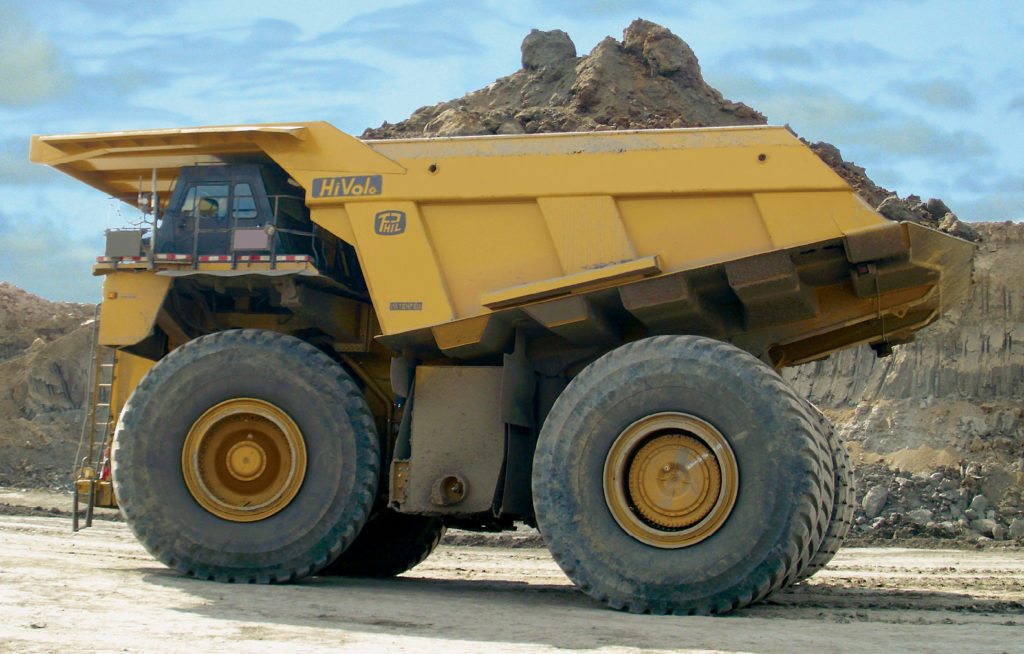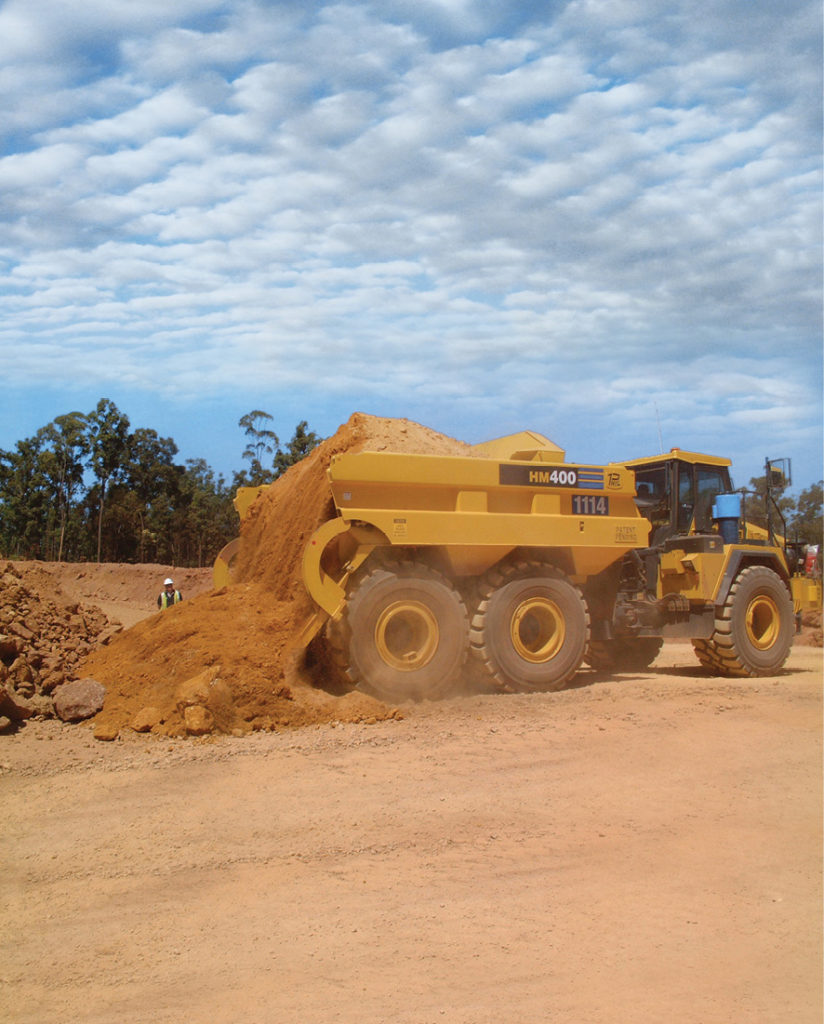Changing the conversation on mine maintenance costs
A new way to address mining cost reduction
through proper equipment selection

Every mine plays its own game of give and take when it comes to reducing expenses. And with the beating that mining equipment, especially truck bodies, face day in and day out, finding ways to balance longevity and productivity creates a challenge. Navigating this decision can leave many mine managers turning to different rules of thumb to help them prioritize operational productivity and equipment durability.
For addressing cost, one popular approach promotes a heavier, durable truck body to give years of low-maintenance operation. These heavy-duty units also tend to be heavy in weight, reducing the amount of material that can be hauled, and heavy in price. These durable bodies tend to outlast the original purchasing manager and leave new management questioning the “heavy duty” approach. In contrast, another school of thought places emphasis on increased hauling capacity and higher productivity from a lighter weight “throwaway” body. These units are lower priced but often wear out quickly, leading to downtime and need for repairs or replacements. Even those seeking some middle ground end up without a viable option in an off-the-shelf truck body that does not maximize the mine’s potential. The only option that provides a unique, sustainable solution to the productivity dilemma is a custom-designed truck body, manufactured to meet the specific challenges of the individual mine.
Here are not only the truck body features that can lead a mine toward an efficient operation, but also a new way to think about reaching a mine’s full potential.
Look at your mine (do not follow trends)
Before a mine manager starts researching truck body features, they need to take a long, hard look at their mine. Is a humid environment causing issues with carryback? Are trucks hauling corrosive materials? Do materials need to exit slowly while dumping the bed? These basic questions lay the groundwork for any equipment decisions. Working with a custom equipment manufacturer adds benefit by working in tandem with the mine to analyze specific requirements while also offering an objective and experienced eye to encourage consideration of often overlooked details.
Finding this synergy and expert insight requires the understanding of what a true custom manufacturer offers. The inclusion of add-ons like sideboards and floor liners is not an indication of a custom manufacturer. Many important options to maximize effectiveness in the mine go far beyond these add-ons to include the truck body’s design, material make-up, and much more. A truly tailored answer to a mine’s durability-productivity problem will address these numerous elements, all the while ensuring that good bones lie underneath any custom solution. And with the instability of steel prices and availability, there is little time and material to waste on not getting a design right the first time.
With the groundwork in place, a mining manager can move on to considering the features that will ensure they are getting a functional, efficient, and durable truck body.
Body basics
No matter the skill level, sometimes operators cannot help but damage ill-fitting off-the-shelf truck bodies when the loading tool comes into contact with the truck body while filling. Whether the truck body is too small, mismatched with the loading tools, or does not have the proper height, repeated damage during loading can quickly destroy a body and cause expensive maintenance and repair issues elsewhere on the truck.
Customizing individual truck bodies to the mine’s specifications increases loading safety and greatly reduces the potential for loading damage by ensuring width is correctly paired with the loading tool. This provides the lowest possible loading height and allows the shovel bucket to get closer to the truck body floor, nearly eliminating the chances that loading equipment will damage the truck’s sides, while simultaneously reducing the whole-body vibration associated with mass dumping. Additionally, choosing a wide body option offers well-balanced weight distribution across all the tires, which reduces the potential for uneven tire wear and extends the truck components and body’s life.
With heavy use and high reliability required in mining applications, maintenance is inevitable. Simple design considerations in the body can either speed the process and decrease issues or lead to delays and additional challenges to address. For example, consider adding four free-floating lifting eyes into the floor of the body rather than the sides. This enables fast and easy removal or installation of a body for maintenance without the risk of bowing the body, a common issue with lifting points incorporated on the sides. As the body sides age, traditional lifting points integrated into the body sides, such as pivots and holes can become fatigued, risking a potential safety situation when removing or installing a body down the road.
Bolsters and frame rails provide maximum reinforcement to the sides and floors of bodies. Traditional bodies simply butt-weld bolsters to frame rails, making them vulnerable to wear and tear. Look for custom bodies with intersecting bolsters and frame rails, as these offer superior support that will not buckle under the immense stress of materials, keeping the payload at maximum capacity.
Ensuring a truck body has these general design features will help to make sure mines get a body with good bones that can be infinitely customized and refurbished to find the sweet spot for handling daily abuse while maintaining productivity. And in the volatile steel market, partnering with a custom manufacturer ensures the best steel is used throughout, and that parts and materials are available and made in-house. Additionally, checking off all these boxes provides mines with a solid base to expand on with other truck body options that can further streamline operations, like rear-eject bodies.
Rear-eject offers an upgrade
Rear-eject bodies provide an efficient, low-maintenance alternative to end-dump trucks for smaller, niche areas within the mine. As the name implies, rear-eject bodies use an ejector blade to discharge material. Without moving or raising the truck bed, the blade pushes material toward the rear of the truck. This simplifies the dumping process and enhances efficiency, since operators do not have to wait for the bed to lower before driving away. Mines can further enhance their level of productivity by keeping an eye out for a few rear-eject features that prioritize simplicity and decrease costly downtime.

When selecting a rear eject, mining operations should keep in mind less is more. Rear-eject bodies constructed with a single hydraulic cylinder minimize maintenance costs and maximize uptime by operating both the ejector blade and the rear tailgate mechanism at the same time. Selecting a body with ejector guides integrated into the inside of the truck bed provides smooth operation and decreases overall maintenance requirements by eliminating rollers that typically break or bind. With the guides and track within the bed, there are no external rails that loader operators can hit, which can disable a unit until costly repairs are made.
Some rear-eject bodies feature designs tailored specifically to reduce carryback. Naturally, the unique sweeping action of the ejector blade reduces the tendency for carryback even with materials prone to sticking to the sides or floor of the truck bed. But certain conditions, such as a humid, sticky environment, pose even greater challenges. In these instances, true custom manufacturers can work with mines to add exotic steel liners to the ejector blade to deter sticking and further ensure no carryback.
Integrating a rear-eject body into a mine has its obvious benefits for dumping, but these bodies can also be fitted with add-on attachments that further increase the flexibility and utility value of the specialty body in the mine.
Spreading and stemming become an option
By safely controlling the dumping rate, when paired with a material spreading attachment, rear-eject trucks can increase efficiency for tasks where materials need to be evenly and precisely distributed. They are ideal for applications such as haul road maintenance or certain drying applications like spreading salt, diatomaceous earth, or lime onto leach beds. These attachments are available from custom-equipment manufacturers and are designed to integrate seamlessly with the rear-eject bodies. Spreading attachments can handle a wide range of material, from very fine to 2-inch-minus-sized material and spread width can be adjusted from approximately 5 feet to 60 feet or more (1.2 to 18.2 meters). In addition to hauling and road maintenance, it can also help to spread grit for traction on icy roads in the winter.
Stemming is another time-consuming task where an attachment can revolutionize productivity and increase rear-eject versatility. Many operations rely on side-dump buckets or loaders to fill blastholes with stemming material after the explosives are packed in the bottom. However, opting for a rear-eject body with a stemming attachment can greatly improve efficiency.
Consider this: using a single 3-ton loader, operators might only be able to fill two holes per load before traveling back to aggregate piles to get more material. Depending on how close the stockpile is, this can result in cycle times of 15 minutes or more. With each blast averaging 100 or more holes, filling the blastholes with stemming material often takes two to four crew members several days, creating a significant drain on productivity.
Alternatively, producers can run a rear-eject body with a stemming attachment on a 40-ton articulated truck, for example, and be able to streamline the process and increase efficiency by 200% or more compared to traditional methods.
Custom rear-eject bodies are compatible with stemming attachments that incorporate into the rear-eject body, offering an adjustable arm that can be easily positioned over the stemming hole to precisely deposit material in less time and with minimal labor. The ejector blade pushes material to a cross auger, which loads the articulating stemming arm and conveyor. The ejector blade speed, in-cab controls, stemming conveyor, and operator controls at the stemming arm all precisely control the flow of material for even distribution.
Finding more cost savings with support solutions does not stop here. A mine’s water tank selection also provides an excellent opportunity for improvement.
Do not forget water tanks
Though they may seem basic, water tanks are crucial for dust suppression, firefighting, and more. Traditional round water tanks limit productivity and increase costs. Round tanks suffer from designs with high sides, which results in a poor center of gravity that can lead to tipping. Instability is worsened by a baffling system that incorporates open maintenance access cutouts leading to poor water compartmentalization and excessive water churn. The safety concerns and instability operators feel in these water trucks result in reservations to completely fill the tank, leading to less efficiency and more trips to refill. To combat this, look for a square tank that addresses these issues from the ground up. The squared off corners and a more sophisticated baffling system can prevent water from surging between compartments and offer easier maintenance access through doors in the baffling, rather than cutouts. Not rounding off the sides also allows for a higher storage capacity, so drivers can be more efficient with their trips.
Lasting Solutions
Every mining manager wants their mine to operate at its full potential, and that usually rides on the back of a haul truck. But designing an operation around one of the industry philosophies that pit durability and productivity against one another rarely offers a sustainable solution. By laying the groundwork and incorporating the assistance, and endless options, available through a fully custom manufacturer, mining managers can include their wants and needs into their unique operation. This close, personal relationship with a custom manufacturer can not only give managers more knowledge about the solutions available for their unique operation, but it can set up a mine for years of future success while others waste time and money bouncing between off-the-shelf options.
Josh Swank is the vice-president of sales and marketing for Philippi-Hagenbuch.
Comments